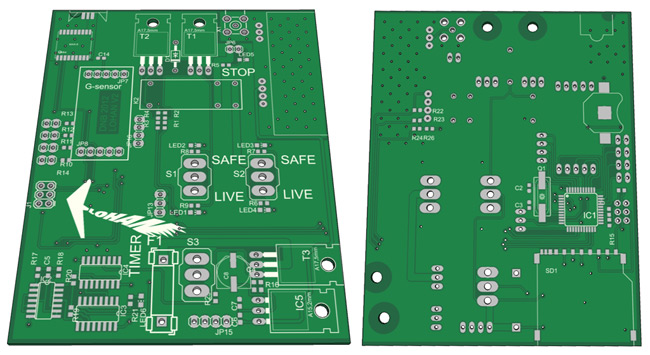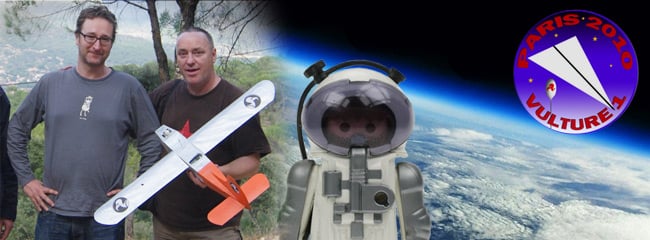This article is more than 1 year old
LOHAN's cold heart beats beneath silicon breast
Spaceplane mission control electronics provisionally dubbed 'HILTON'
Our crack Low Orbit Helium Assisted Navigator (LOHAN) electronics team has made some cracking progress over the past few weeks, putting together the beating heart that will control our audacious Vulture 2 spaceplane mission.
 A couple of months back, we decided to fire the aircraft's solid rocket motor using a GPS trigger, having scrapped our initial plan to deploy a barometric altimeter.
A couple of months back, we decided to fire the aircraft's solid rocket motor using a GPS trigger, having scrapped our initial plan to deploy a barometric altimeter.
Back in June, reader Neil Barnes kindly sent over an altimeter based on the Intersema MS5534 temperature compensated pressure sensor, which didn't fare too well in the Rocketry Experimental High Altitude Barosimulator (REHAB) chamber of death.
Although Neil identified a software glitch as the cause of the failure, serious doubts over the accuracy and reliability of barometric sensors at altitude led us to adopt an alternative line of attack.
Enter stage left Anthony Stirk, and his Swift board (pictured below), designed for long-duration High Altitude Ballooning (HAB) missions. The Swift boasts a ATMega644 microprocessor, two Radiometrix radio modules and, critically for LOHAN, a uBlox MAX-6 GPS - good to 50,000m.
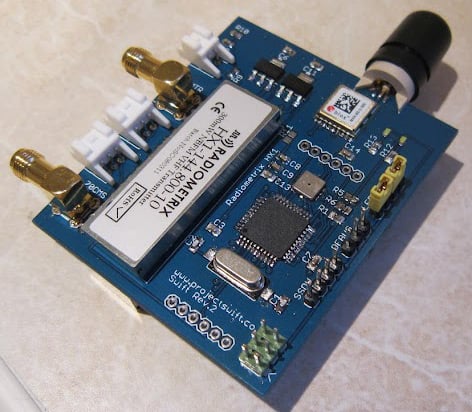
There's more on Anthony and the Swift board here. In fact, our finished LOHAN board won't be a Swift, but rather an entirely new beast based on the basic design and modified according to LOHAN mission requirements.
Anthony and Neil quickly formed an unholy electronic alliance to bend the board to LOHAN's will, and have now produced a functioning prototype of what will ultimately ensure the Vulture 2's mighty thruster breathes fire at the required altitude.
Here's a snap of Neil working on the board's schematic (more on that below), and at bottom left you can see said prototype...
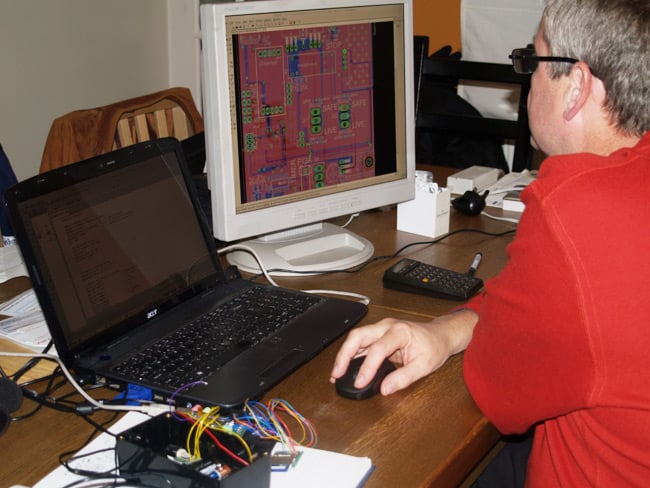
...which currently looks like this:
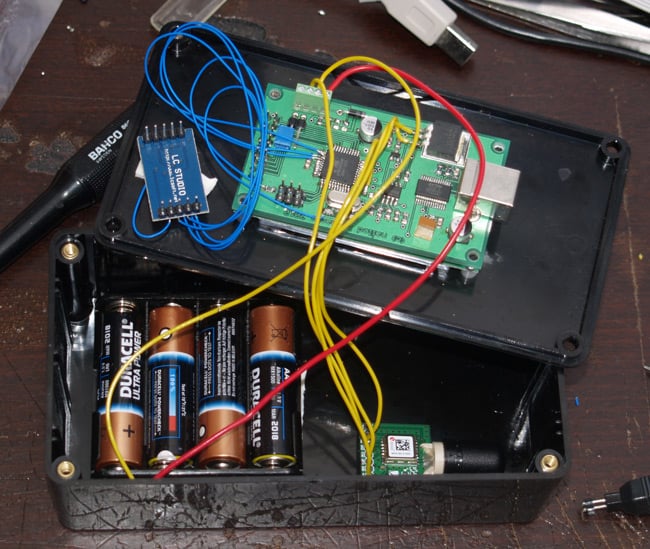
The central board is actually an old bit of kit Neil designed to talk to his car's electronic control unit. We still have the ATMega644 microprocessor and uBlox MAX-6 GPS, but a new addition is the ADXL345 3-axis accelerometer, seen at top left.
The basic plan is pretty simple: At the desired altitude, as read by the GPS, the board will fire the Vulture 2 rocket motor. The accelerometer will help determine the status of the fantastical flying truss bearing the aircraft.
At bottom right is the GPS antenna, and you can see the 6V battery supply to the board at bottom left.
Not yet present are the SD card (for data logging purposes), the radio transmitter, three temperature sensors attached to an analogue input, and the motor igniter set-up. There will be a connection for the RockBLOCK Iridium satellite comms module, which arrived last week hot from the fab plant via Rock Seven.
The motor igniter circuitry is the most critical piece of the puzzle. Ignition will be triggered when the processor fires two transistors (for redundancy) which close a relay between Rob Eastwood's custom igniter and an independent 12V supply.
Neil explains: "It will fire if the current altitude is above 20,000 metres (to be clear of air traffic) and we achieve the desired launch height."
On the day, we'll have the capacity for two balloon flights. If on the first flight we don't get a successful launch, we'll recover the Vulture 2 with the flying truss after they return to terra firma.
On the second flight, when we'll have to go for a launch no matter what, the processor will trigger motor ignition according to the two parameters stated above, and it will also send the Vulture 2 on its way when it detects the truss is falling by either the zero-g sensor triggering or by the GPS indicating descent.
The planned Vulture 2 rocket motor is a bit of a monster, so we have some safety features on board. Neil has designed a system of switches and LEDs, which works as follows:
For launching we enable things a step at a time. If at any time, we don't see the lights we expect, and in particular if we see the 'STOP' light, we abort. We start with the power disconnected from the board and the igniter cable disconnected.
- Set all three switches off - this should give two yellow 'SAFE' lights. It disconnects power from both the relay coil and the relay contacts, and resets and stops the timer.
- Turn S1 on: this powers the coil side of the relay and sets its red 'LIVE' light.
- Turn S2 on: this powers the contact side of the relay, and sets its red 'LIVE' light. If there is a contact fault in the relay, this will light the 'STOP' light. That indicates that the igniter contact is live; it's a bad idea to attach the igniter at this point.
- If we're happy with just two red lights, we can attach the igniter.
- The final act, just before we launch, is to turn S3 on which starts the timer - look for a flashing 'TIMER' light - and two and a half hours later the fuse blows.
As you've doubtless already worked out, the timer is to ensure that, in the event the motor doesn't fire and we don't recover the aircraft rapidly, the igniter power supply is dead. Should some passerby stumble upon the Vulture 2 on the ground before we can get to it, there won't be any juice left to accidentally set off the igniter.
Neil says: "At two and a half hours, more or less, it will trigger the crowbar silicon-controlled rectifier which will stick a dead short across the igniter batteries and hold it until it drops to zero. Either the fuse blows, the circuit board tracks melt, or any weak links in the wiring break... or eventually the battery goes flat. In any case, there is now no charge available to fire the rocket, if it's still present."
If you think all of the above is still at the garden shed stage, think again. Neil has prepared the aforementioned schematic, and Anthony sent over a rendering of the board, to give a taster of how it will look:
We're hoping to have the finished board printed and ready for assembly in the next couple of weeks, after which we'll have to mull just how best to test the system.
We'll also need a snappy acronym or backronym for our shiny new kit, as is the local custom. Neil suggested "High Ignition Launch and Time Out Neutraliser" (HILTON), although he admitted struggling with the "N".
No doubt our talented readers can provide alternative suggestions, and when we have a critical mass of linguistic tomfoolery, we'll put the best entries up for the traditional public vote.
While you're pondering that, we're sure you'll join us in raising a pint or two to Anthony and Neil for their excellent work. ®
Further LOHAN resources:
- New to LOHAN? Try this mission summary for enlightenment.
- You can find full LOHAN coverage right here.
- Join the expert LOHAN debate down at Reg forums.
- All the LOHAN and Paper Aircraft Released Into Space (PARIS) vids live on YouTube.
- For our SPB photo archive, proceed directly to Flickr.
- We sometimes indulge in light consensual tweeting, as you can see here.
